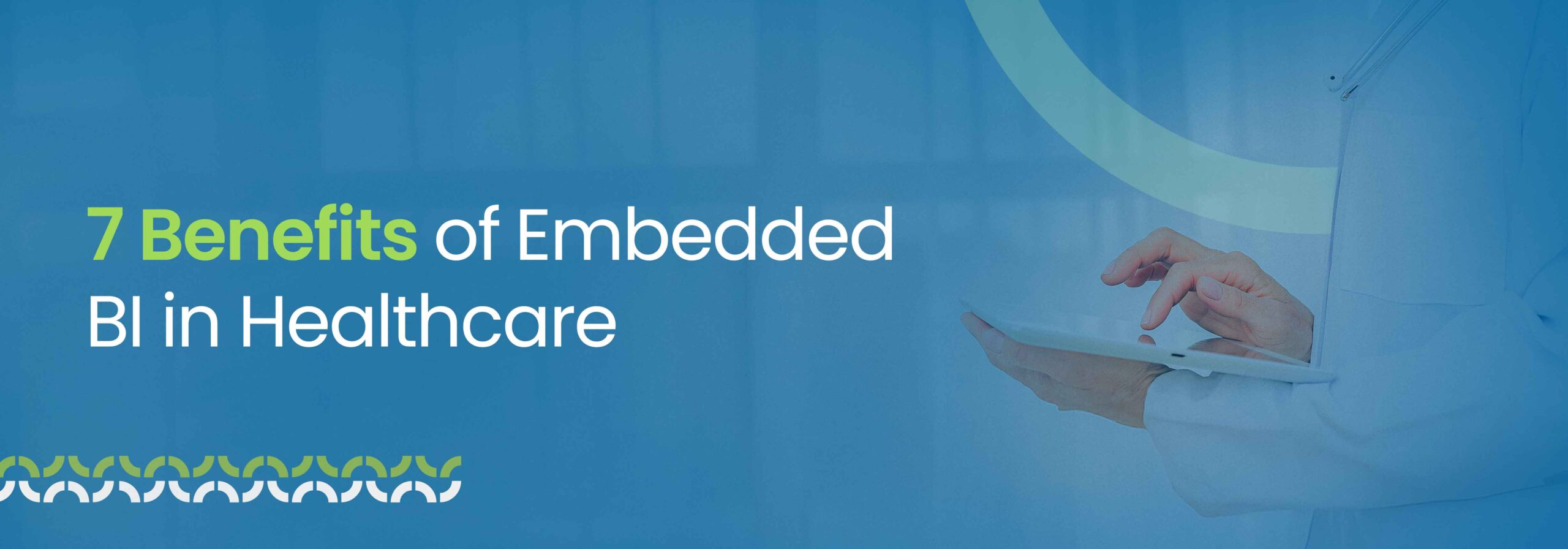The healthcare sector is a department with ever-evolving changes with new technologies and methodologies to deliver better patient care and streamline administrative operations. One such advancement is healthcare business intelligence with integrated features of analytic tools to analyze data. Healthcare BI helps to improve the efficiency and effectiveness of healthcare services and systems automatically.
Embedded BI comprises large data collection, mining, storage, and processing, as well as visualization, predictive analysis, performance management with advanced reporting. Also, BI plays an important role for healthcare providers to make informed clinical decisions for improved patient outcomes, financial issues, and operational management. In this blog we will explore seven key benefits of embedded BI in healthcare, and how they are working all together to create a smooth and efficient healthcare experience.

7- Key Benefits of Healthcare Business Intelligence
1. Improved Patient Care and Outcomes:
One of the most impactful applications of business intelligence for healthcare providers is to enhance patient care and outcome. Embedded BI in healthcare allows users to access real-time data and analytics within their workflow. This immediacy helps physicians, doctors, and other medical professionals to gain insights into a patient’s medical history, diagnoses, and other laboratory reports. With analytics embedded directly into patient management systems, medical care providers can identify patient risk and take proactive measures to prevent them, without switching between systems.
For example, predictive analytics powered by embedded BI can identify patients at risk of developing certain conditions or complications, allowing for proactive interventions. Early detection of chronic diseases like diabetes or heart conditions can lead to better long-term outcomes for patients.
Tip:
Self-Service BI tool is also available for patients, who receive quick access to their personal data.
2. Increased Operational Efficiency:
Healthcare organizations are complicated, with numerous departments and systems working together to provide patient care. Embedded BI tools can greatly enhance operational efficiency by providing insights into hospital workflows, resource usage, and overall staff performance. Healthcare professionals can use data-driven insights to optimize staff schedules, reduce patient wait times, and ensure that medical equipment and supplies are advanced stocked.
In addition, business intelligence software tools help identify areas where resources may be underutilized, allowing healthcare administrators to allocate resources more effectively. This leads to smoother administrative operations and ultimately improves the overall patient experience.
3. Real-Time Insights for Quick Decisions:
One of the most significant advantages of embedded BI is its ability to provide real-time data and analytics access anytime, anywhere. In healthcare, decision-makers need up-to-the-minute information to make critical choices. Embedded BI integrates seamlessly with Electronic Health Records (EHR) and other clinical systems, giving healthcare providers immediate access to patient data and actionable insights.
Real-time access allows healthcare professionals to make quicker, more informed decisions, whether it’s in an emergency situation or during routine patient care. For example, having access to a real-time view of a patient’s vital signs can help healthcare workers identify potential issues before they become critical, improving response times and patient outcomes.
4. Cost Reduction and Revenue Management:
Healthcare providers are under constant pressure to manage costs while maintaining high levels of patient care. Embedded BI plays an important role in helping healthcare organizations reduce operational costs by providing insights into financial data. By identifying inefficiencies, waste, or overuse of resources, healthcare administrators can make informed decisions to optimize spending expenditures.
For instance, BI can analyze patient billing data to ensure accuracy and highlight areas of potential revenue loss due to coding errors or missed charges. Moreover, predictive analytics helps healthcare organizations forecast expenses and budget more effectively, ensuring that resources are allocated where they’re needed most without overspending.

5. Internal Collaboration and Communication:
Effective collaboration and communication among healthcare teams are essential for delivering quality care. Embedded BI enables seamless data sharing and collaboration by providing a unified view of patient information, making it easier for different departments and specialists to communicate with one another.
Healthcare professionals across departments, from doctors and nurses to administrators and lab technicians, can access the same data, reducing misunderstandings and improving teamwork. This approach to data sharing leads to better decision-making, coordinated care, and faster resolutions to patient issues.
6. Automated Regulatory Compliance and Reporting:
The healthcare industry is subject to a wide range of regulations and standards, such as HIPAA, CMS that require healthcare providers to maintain strict data privacy and security protocols. Embedded BI helps organizations ensure compliance with regulations by automating data collection and reporting processes, while also keeping the system updated with future changes.
With embedded BI, healthcare providers can generate accurate, real-time reports for audits and regulatory submissions. By centralizing and automating data management, healthcare organizations reduce the risk of errors and ensure they meet compliance standards. BI tools also facilitate better tracking and management of patient consent forms, medical records, and other compliance-related tasks, making it easier for healthcare providers to stay on top of legal requirements, and avoid any costly penalties.
7. Enhanced Research and Disease Prediction:
Embedded BI is a game-changer when it comes to predictive analytics in healthcare. With the help of advanced algorithms, embedded BI tools can analyze vast amounts of data to forecast patient outcomes, identify trends, and provide early warnings for potential health issues.
For example, hospitals can use predictive models to anticipate patient readmissions, enabling healthcare providers to take preventive actions, such as follow-up care, early interventions, or personalized treatment plans. Predictive analytics can also help in managing chronic conditions more effectively, reducing hospitalizations, and improving long-term patient outcomes.
Final Thoughts
Embedded BI is transforming healthcare by offering data-driven insights that improve patient care, optimize operations, and enhance financial management. From real-time access to patient data to predictive analytics for better outcomes, the integration of BI into healthcare systems is an invaluable tool for driving efficiency and improving the quality of care.
As the healthcare industry continues to evolve, adopting embedded BI solutions will be key to maintaining a competitive edge, ensuring regulatory compliance, and ultimately delivering superior patient care. For healthcare organizations looking to stay ahead, the time to embrace embedded BI is now.

